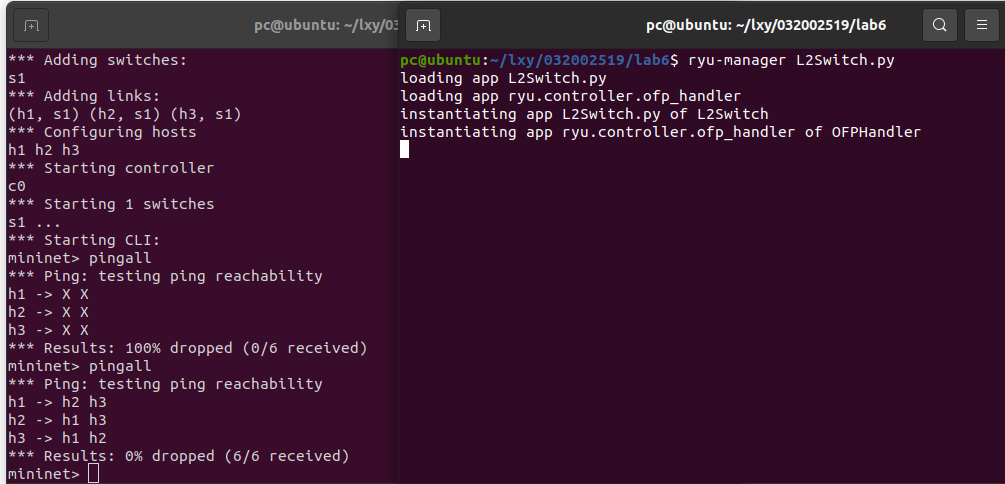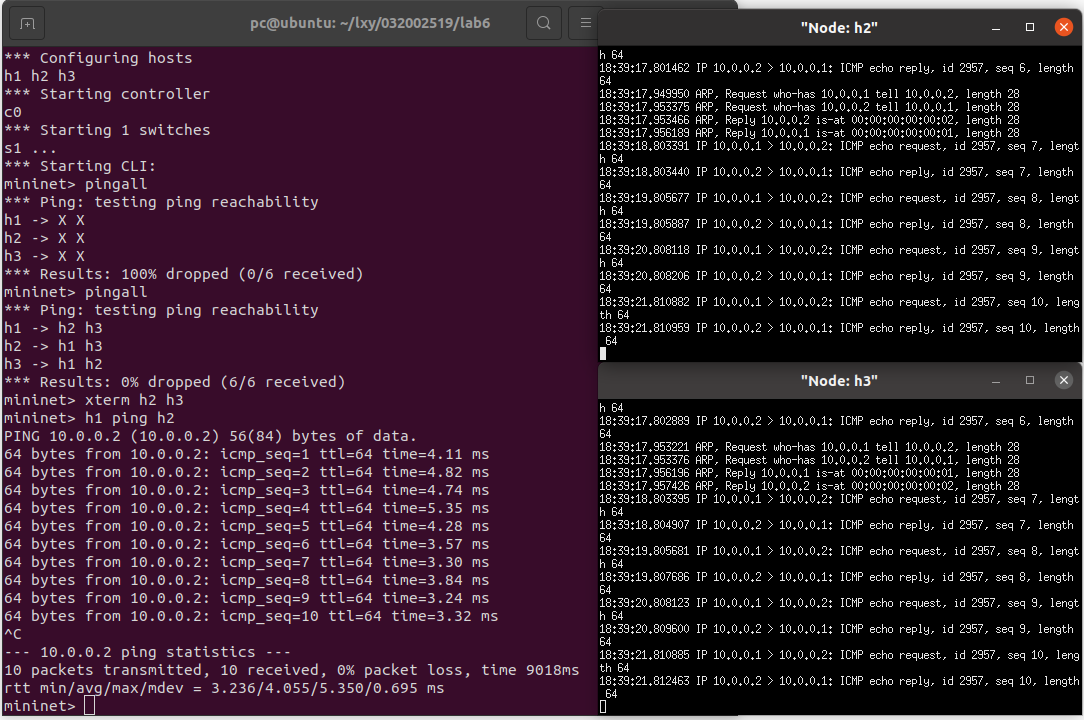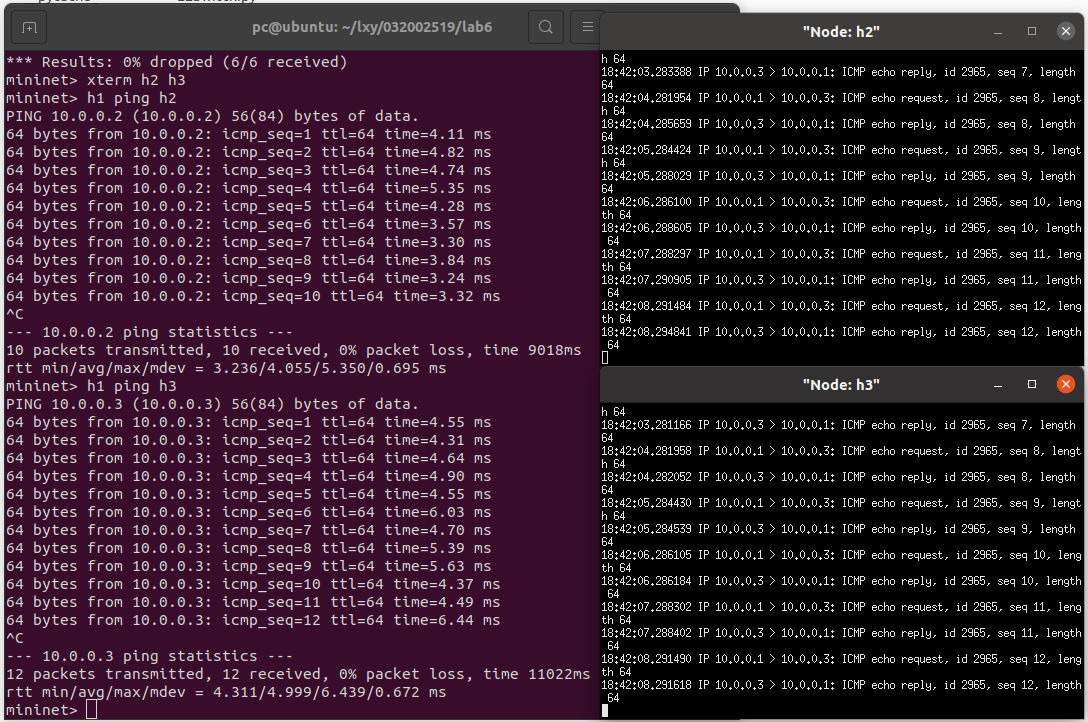实验6:开源控制器实践——RYU
实验6:开源控制器实践——RYU
一、实验目的
- 能够独立部署RYU控制器;
- 能够理解RYU控制器实现软件定义的集线器原理;
- 能够理解RYU控制器实现软件定义的交换机原理。
二、实验环境
Ubuntu 20.04 Desktop amd64
三、实验要求
(一)基本要求
(1) 搭建下图所示SDN拓扑,协议使用Open Flow 1.0,并连接Ryu控制器,通过Ryu的图形界面查看网络拓扑
(2) 阅读Ryu文档的The First Application一节,运行并使用 tcpdump 验证L2Switch
- 运行L2Switch

- h1 ping h2

- h1 ping h3

(3)分析L2Switch和POX的Hub模块有何不同
RYU的L2Switch模块和POX的Hub模块都是洪泛转发,但是ryu的L2Switch模块运行时不可查看流表,而pox的Hub模块运行时可查看流表
(4)编程修改L2Switch.py,另存为L2032002126.py,使之和POX的Hub模块的变得一致。
- 运行L2032002126.py

- 查看流表

- L2032002519.py代码
from ryu.base import app_manager
from ryu.ofproto import ofproto_v1_3
from ryu.controller import ofp_event
from ryu.controller.handler import MAIN_DISPATCHER, CONFIG_DISPATCHER
from ryu.controller.handler import set_ev_cls
class hub(app_manager.RyuApp):
OFP_VERSIONS = [ofproto_v1_3.OFP_VERSION]
def __init__(self, *args, **kwargs):
super(hub, self).__init__(*args, **kwargs)
@set_ev_cls(ofp_event.EventOFPSwitchFeatures, CONFIG_DISPATCHER)
def switch_feathers_handler(self, ev):
datapath = ev.msg.datapath
ofproto = datapath.ofproto
ofp_parser = datapath.ofproto_parser
# install flow table-miss flow entry
match = ofp_parser.OFPMatch()
actions = [ofp_parser.OFPActionOutput(ofproto.OFPP_CONTROLLER, ofproto.OFPCML_NO_BUFFER)]
# 1\OUTPUT PORT, 2\BUFF IN SWITCH?
self.add_flow(datapath, 0, match, actions)
def add_flow(self, datapath, priority, match, actions):
# 1\ datapath for the switch, 2\priority for flow entry, 3\match field, 4\action for packet
ofproto = datapath.ofproto
ofp_parser = datapath.ofproto_parser
# install flow
inst = [ofp_parser.OFPInstructionActions(ofproto.OFPIT_APPLY_ACTIONS, actions)]
mod = ofp_parser.OFPFlowMod(datapath=datapath, priority=priority, match=match, instructions=inst)
datapath.send_msg(mod)
@set_ev_cls(ofp_event.EventOFPPacketIn, MAIN_DISPATCHER)
def packet_in_handler(self, ev):
msg = ev.msg
datapath = msg.datapath
ofproto = datapath.ofproto
ofp_parser = datapath.ofproto_parser
in_port = msg.match['in_port'] # get in port of the packet
# add a flow entry for the packet
match = ofp_parser.OFPMatch()
actions = [ofp_parser.OFPActionOutput(ofproto.OFPP_FLOOD)]
self.add_flow(datapath, 1, match, actions)
# to output the current packet. for install rules only output later packets
out = ofp_parser.OFPPacketOut(datapath=datapath, buffer_id=msg.buffer_id, in_port=in_port, actions=actions)
# buffer id: locate the buffered packet
datapath.send_msg(out)
(二)进阶要求
(1)阅读Ryu关于simple_switch.py和simple_switch_1x.py的实现,以simple_switch_13.py为例,完成其代码的注释工作
#
# Licensed under the Apache License, Version 2.0 (the "License");
# you may not use this file except in compliance with the License.
# You may obtain a copy of the License at
#
# http://www.apache.org/licenses/LICENSE-2.0
#
# Unless required by applicable law or agreed to in writing, software
# distributed under the License is distributed on an "AS IS" BASIS,
# WITHOUT WARRANTIES OR CONDITIONS OF ANY KIND, either express or
# implied.
# See the License for the specific language governing permissions and
# limitations under the License.
from ryu.base import app_manager
from ryu.controller import ofp_event
from ryu.controller.handler import CONFIG_DISPATCHER, MAIN_DISPATCHER
from ryu.controller.handler import set_ev_cls
from ryu.ofproto import ofproto_v1_3
from ryu.lib.packet import packet
from ryu.lib.packet import ethernet
from ryu.lib.packet import ether_types
class SimpleSwitch13(app_manager.RyuApp):
OFP_VERSIONS = [ofproto_v1_3.OFP_VERSION] # 定义openflow版本为Openflow1.3
def __init__(self, *args, **kwargs):
super(SimpleSwitch13, self).__init__(*args, **kwargs)
self.mac_to_port = {} # 定义保存mac地址到端口的一个映射
# 处理SwitchFeatures事件
@set_ev_cls(ofp_event.EventOFPSwitchFeatures, CONFIG_DISPATCHER)
def switch_features_handler(self, ev):
datapath = ev.msg.datapath #交换机的相关信息
ofproto = datapath.ofproto
parser = datapath.ofproto_parser
# install table-miss flow entry
#
# We specify NO BUFFER to max_len of the output action due to
# OVS bug. At this moment, if we specify a lesser number, e.g.,
# 128, OVS will send Packet-In with invalid buffer_id and
# truncated packet data. In that case, we cannot output packets
# correctly. The bug has been fixed in OVS v2.1.0.
match = parser.OFPMatch() # match指流表项匹配,OFPMatch()指不匹配任何信息
actions = [parser.OFPActionOutput(ofproto.OFPP_CONTROLLER,
ofproto.OFPCML_NO_BUFFER)] # actions:动作
self.add_flow(datapath, 0, match, actions) # add_flow()增加流表项
def add_flow(self, datapath, priority, match, actions, buffer_id=None):
ofproto = datapath.ofproto # 获取交换机信息
parser = datapath.ofproto_parser
inst = [parser.OFPInstructionActions(ofproto.OFPIT_APPLY_ACTIONS,
actions)]
if buffer_id: # 判断是否存在buffer_id,并生成mod对象
mod = parser.OFPFlowMod(datapath=datapath, buffer_id=buffer_id,
priority=priority, match=match,
instructions=inst)
else:
mod = parser.OFPFlowMod(datapath=datapath, priority=priority,
match=match, instructions=inst)
datapath.send_msg(mod) # send_msg(mod)即为下发流表
# 处理PacketIn事件
@set_ev_cls(ofp_event.EventOFPPacketIn, MAIN_DISPATCHER)
def _packet_in_handler(self, ev):
# If you hit this you might want to increase
# the "miss_send_length" of your switch
if ev.msg.msg_len < ev.msg.total_len:
self.logger.debug("packet truncated: only %s of %s bytes",
ev.msg.msg_len, ev.msg.total_len)
# 解析数据结构
msg = ev.msg # ev.msg 是代表packet_in data structure对象
datapath = msg.datapath
# dp. ofproto 和 dp.ofproto_parser 是代表 Ryu 和交换机谈判的 OpenFlow 协议的对象
# dp.ofproto and dp.ofproto_parser are objects that represent the OpenFlow protocol that Ryu and the switch negotiated
ofproto = datapath.ofproto
parser = datapath.ofproto_parser
in_port = msg.match['in_port'] # 获取源端口
pkt = packet.Packet(msg.data)
eth = pkt.get_protocols(ethernet.ethernet)[0]
if eth.ethertype == ether_types.ETH_TYPE_LLDP:
# 忽略LLDP类型的数据包
return
dst = eth.dst # 目的端口
src = eth.src # 源端口
dpid = format(datapath.id, "d").zfill(16)
self.mac_to_port.setdefault(dpid, {})
self.logger.info("packet in %s %s %s %s", dpid, src, dst, in_port)
# 学习包的源地址,和交换机上的入端口绑定
# learn a mac address to avoid FLOOD next time.
self.mac_to_port[dpid][src] = in_port
# 查看是否已经学习过该目的mac地址
if dst in self.mac_to_port[dpid]: # 如果目的地址存在于mac_to_port中
out_port = self.mac_to_port[dpid][dst]
# 否则,洪泛
else:
out_port = ofproto.OFPP_FLOOD # OFPP_FLOOD标志表示应在所有端口发送数据包,即洪泛
actions = [parser.OFPActionOutput(out_port)]
# 下发流表避免下次触发 packet in 事件
# install a flow to avoid packet_in next time
if out_port != ofproto.OFPP_FLOOD:
match = parser.OFPMatch(in_port=in_port, eth_dst=dst, eth_src=src)
# verify if we have a valid buffer_id, if yes avoid to send both
# flow_mod & packet_out
if msg.buffer_id != ofproto.OFP_NO_BUFFER:
self.add_flow(datapath, 1, match, actions, msg.buffer_id)
return
else:
self.add_flow(datapath, 1, match, actions)
data = None
if msg.buffer_id == ofproto.OFP_NO_BUFFER:
data = msg.data
# 发送Packet_out数据包,带上交换机发来的数据包的信息
out = parser.OFPPacketOut(datapath=datapath, buffer_id=msg.buffer_id,
in_port=in_port, actions=actions, data=data)
# 发送流表
datapath.send_msg(out)
(2)回答下列问题
- 代码当中的mac_to_port的作用是什么?
保存mac地址到交换机端口的映射
- simple_switch和simple_switch_13在dpid的输出上有何不同?
在simple_switch_13.py中使用了zfill() 方法返回指定长度为16的字符串,原字符串右对齐,前面填充0;而simple_switch.py直接输出dpid
- 相比simple_switch,simple_switch_13增加的switch_feature_handler实现了什么功能?
增加了实现交换机以特性应答消息响应特性请求功能
- simple_switch_13是如何实现流规则下发的?
在触发PacketIn事件后,首先获取协议信息、获取源端口、包学习,交换机信息,以太网信息等。如果以太网类型是LLDP类型的话,则忽略不处理。否则,则获取目的端口和源端口和交换机id的信息,进行交换机自学习:先学习源地址对应的交换机的入端口,再查看是否已经学习目的mac地址,如果没有学习过就洪泛转发。如果学习过,则查看是否有buffer_id,如果有,那么在添加流时加上buffer_id,向交换机发送数据包和流表
- switch_features_handler和_packet_in_handler两个事件在发送流规则的优先级上有何不同?
switch_features_handler下发流表的优先级比_packet_in_handler的高
(3)硬超时功能

四、个人总结
遇到的问题及解决方法
(1)在运行
L2switch.py后却一直ping不通,后经过检查,发现是前一步中ryu没有关闭导致错误,关闭之后,问题解决;(2)在运行L2032002519.py时,出现unsupported version 0x1,运行了几遍之后依然不行,就先去看已经完成的同学是否有同样的问题,后经过查找发现还是有一部分同学出现过同样问题,学习了问题出现的根本原因便进行改正,在将版本设置为“protocols=OpenFlow13后”,问题解决
心得体会
本次实验难度适中,总体来说跟着pdf文档就能较为轻松的完成,但是主要的获取的知识是在实验中的一些结论与靠阅读RYU相关模块的源代码获得的。比如ryu的L2Switch模块与pox的Hub模块的不同在于ryu的L2Switch模块运行时不可查看流表,而pox的Hub模块运行时可查看流表。主要是进阶部分会比较艰难一点,代码比较多而且实现的功能需要认真理解,但是坚持读下来,就会对ryu的控制机制有深入的理解与认识






 浙公网安备 33010602011771号
浙公网安备 33010602011771号